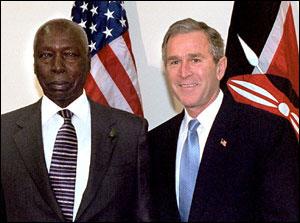Daniel arap Moi
|
|
Daniel Toroitich arap Moi (born September 2, 1924) was the President of Kenya from 1978 until 2002.
Born in Sacho, Baringo district, Rift Valley province, Daniel arap Moi was raised by his mother Kimoi Chebii following the early death of his father. After completing his secondary education, he attended the Teacher Training College in Kapsabet. He worked as a teacher from 1946 until 1955.
Moi entered politics in 1955, when he was elected Member of the Legislative Council for Rift Valley. Together with Ronald Ngala, he founded the Kenya African Democratic Union (KADU) in 1960, to challenge the Kenya African National Union (KANU) led by Mzee Jomo Kenyatta. KADU's aim was to defend the interests of the small minority tribes, such as the Kalenjin to which Moi belonged, against the dominance of the big Luo and Kĩkũyũ tribes that comprised the majority of KANU's membership (Kenyatta himself being a Kĩkũyũ). KADU pressed for a federal constitution, while KANU was in favour of centralism. The advantage lay with the numerically stronger KANU, and the British government was finally forced to remove all provisions of a federal nature from the constitution.
Re-elected Member of the Legislative Council for Rift Valley in 1957, and then as MP for Baringo North in 1961, Moi became Minister of Education in the pre-independence government of 1960–1961.
After Kenya's independence on December 12, 1963, convinced by Kenyatta of the necessity to unite forces in order to complete the decolonisation process, Moi agreed to merge KADU with KANU. Thus Kenya became a de facto one-party state, dominated by the Kĩkũyũ-Luo alliance. Kenyatta thanked Moi by promoting him, first to Minister for Home Affairs in 1964, and then to vice-president in 1967.
Having thus become Kenyatta's right-hand man, Moi smoothly stepped into his place when "the Father of Independence" died on August 22, 1978. Initially he was popular, but Kĩkũyũ resentment against his elevation and economic recession gradually sapped his regime's perceived legitimacy. After a failed coup attempt by a group of Air Force officers on August 1, 1982, Moi changed the constitution to establish a de jure one-party state, and resorted to strong-arm rule, including torture and imprisonment without trial. This led the United States to withhold aid in the late 1980s, whereupon he was forced to restore a multiparty system in December 1991. Moi won elections in 1992 and 1997, but many people were killed in events related to each, and Moi was widely suspected of exploiting ethnic tensions in these contests.
Over the years, Moi's regime became increasingly corrupt. Political violence damaged the tourism industry, and reform programmes imposed by the IMF and the World Bank did not succeed in lifting the country out of the economic quagmire. He was also heavily implicated in the Goldenberg scandal.
Constitutionally barred from running in the 2002 presidential elections, Moi unsuccessfully promoted Uhuru Kenyatta, the son of Kenya's first President, as his successor. In what arguably were the country's first free and fair elections, a rainbow coalition of opposition parties routed the ruling KANU party, and its leader, Mwai Kibaki, was elected President by a slim majority which was confirmed on December 29, 2002.
| Preceded by: Jomo Kenyatta |
President of Kenya | Succeeded by: Mwai Kibaki |

